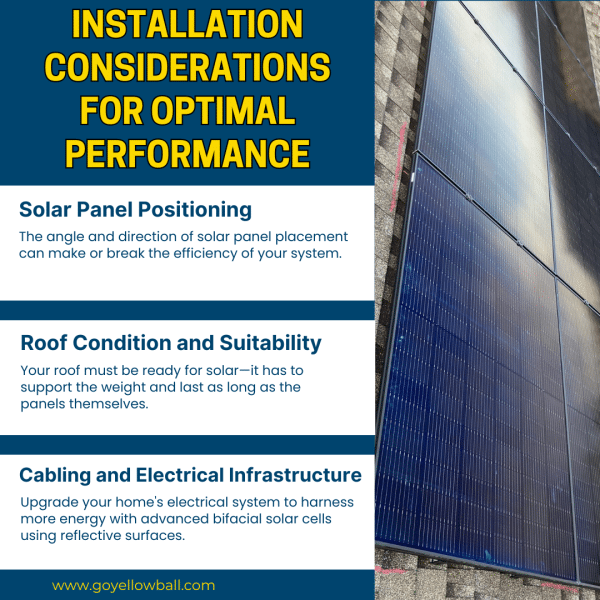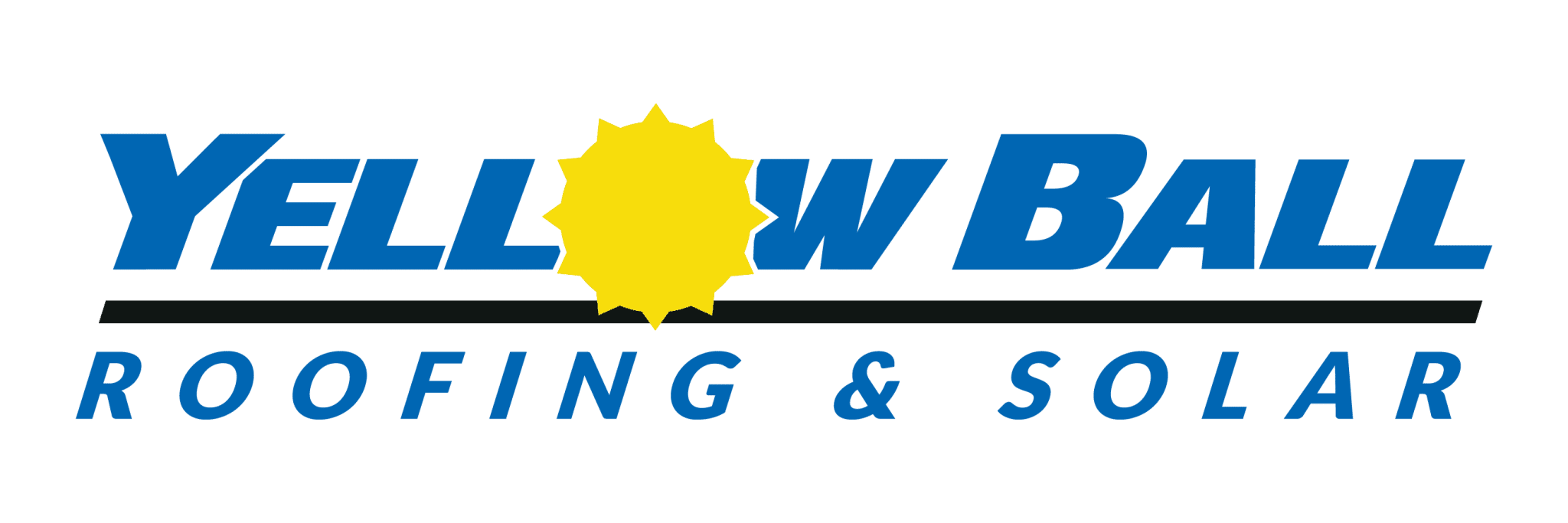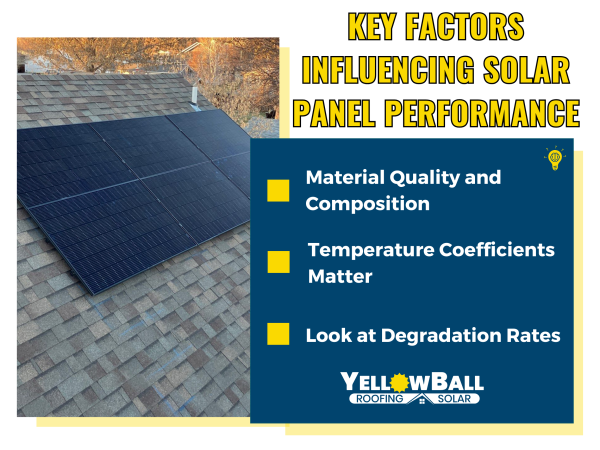YellowBall Roofing & Solar empowers Montana homes with top-notch solar solutions. Exploring the best solar panels can revolutionize your energy consumption and financial situation.
We’re here to guide you through what makes a panel stand out in efficiency and how it translates to better performance.
You’ll get the scoop on factors that boost panel output, like quality materials and intelligent installation.
Plus, we’ll tackle residential favorites and commercial powerhouses in today’s market.
And don’t worry; we cover cutting-edge tech pushing solar further along with tips on warranties and support because going green should also mean peace of mind.
Ready to make your home a model of sustainability and efficiency? Contact YellowBall Roofing & Solar today and take the first step towards a greener, more cost-effective future.
Table Of Contents:
- Understanding Solar Panel Efficiency
- Key Factors Influencing Solar Panel Performance
- Types of Solar Panels Available in the Market
- Top Picks for Residential Solar Panels
- Choosing Commercial Solar Panels
- Innovations in Solar Technology
- Installation Considerations for Optimal Performance
- Warranties and After-Sales Support in Choosing Solar Panels
- FAQs about Best Solar Panels
- Discovering the Ideal Solar Panels for Your Home’s Energy Demands
Understanding Solar Panel Efficiency
Solar panel efficiency measures how well your solar panels can convert sunlight into usable electricity.
This efficiency is critical, as it directly determines how effectively your system converts sunlight into power for your home or business.
Essential Influences on Solar Panel Efficiency
The performance of solar panels hinges on several factors. First, material quality takes center stage; higher-grade silicon means better efficiency.
Temperature coefficients are essential since higher temperatures typically reduce solar panel efficiency. The panels need to maintain performance even as they heat up.
Additionally, degradation rates are crucial; they indicate how much a solar panel’s energy output will diminish over time. A lower degradation rate signifies that the panels will sustain their productivity longer.
To get a clearer picture, the National Renewable Energy Laboratory (NREL) provides insights into these metrics and their impact on solar panel longevity and effectiveness.
Solar Panel Varieties on the Market
In the current market, three primary types of solar panels prevail:
- Monocrystalline is known for its high efficiency and aesthetic appeal.
- Polycrystalline offers a more affordable price point at the expense of lower efficiency.
- Thin film is notable for its flexible application but potentially compromised durability.
Dive deeper through the SolarReviews guide, which breaks down each type’s pros and cons, helping you navigate this landscape like a pro.
Best Residential Solar Panels Selection
We’ve analyzed extensive data to spare homeowners the effort.
Our selections are based not only on maximum efficiencies but also on solar panel warranties that offer reassurance and customer reviews that illuminate practical performance, which is essential for making an informed choice quickly.
Key Takeaway:
Maximize efficiency by optimizing solar panel selection by considering material quality, temperature response, and degradation rate. Utilize resources like NREL for technical details and the Energy Department’s guide to navigate between monocrystalline (high efficiency), polycrystalline (budget-friendly), or thin-film (versatile) options. For residential choices, evaluate based on efficiency ratings, warranties, and user reviews from sites like SolarReviews.com.
Key Factors Influencing Solar Panel Performance
Solar panel performance hinges on more than just sun exposure; it involves a complex interaction of multiple factors.
The output of solar panels depends on their construction, including materials and design, as well as external environmental conditions such as weather.
Material Quality and Composition
Solar panels’ material quality and composition can majorly impact their conversion efficiency.
Monocrystalline silicon, known for its high efficiency, is often considered the premium option compared to polycrystalline silicon, which trades off some efficiency for cost savings.
Solar companies are investing significantly in research to develop materials that enhance energy capture, ensuring you get a higher return on investment from every ray of sunlight absorbed by the solar panels.
Temperature Coefficients Matter
Contrary to what some might assume, hotter days do not necessarily equate to better solar performance.
Solar panels are affected by their temperature coefficient. A higher temperature coefficient solar panel means the efficiency decreases as temperatures increase.
Selecting panels with lower temperature coefficients is essential if your location experiences intense sunlight regularly.
Look at Degradation Rates
Just as athletes experience a decline in their prime condition over time, solar panels also face performance degradation.
This rate of decline varies across products and manufacturers.
Typically, there’s an average loss of about 0.5% after the first year, with a gradual decrease following that period.
We aim to offer options engineered for durability so that this reduction in efficiency occurs at a slower pace.
Choosing top-performing solar panels involves more than considering cost or appearance; it necessitates understanding these subtle yet significant details, which ultimately distinguish satisfactory from exceptional long-term outcomes.
Key Takeaway:
Think of solar panels like star athletes, where performance hinges on quality materials and design, the right external conditions, and keeping degradation at bay. Remember: hotter isn’t always better due to temperature coefficients and long-term efficiency matters more than initial savings.
Types of Solar Panels Available in the Market
Knowing the best solar panels available options when considering solar energy is critical for informed decision-making.
YellowBall Roofing & Solar sees various customers, from eco-conscious homeowners to forward-thinking businesses, and each has unique needs.
Monocrystalline Solar Panels
The classic choice for many is monocrystalline solar panels.
They are known for their sleek black look and the highest efficiency rates because they are made from single-crystal silicon.
Although they might come with a higher upfront price, their longevity often translates into better value over time.
Their construction allows them to perform more effectively in low-light conditions compared to other types—which means even on cloudy days, you could still see some solar power output.
This reliability makes them a go-to for residential installations where space may be limited, but performance is paramount.
Polycrystalline Solar Panels
If budget considerations are top of mind, but you don’t want to compromise too much on quality, polycrystalline solar panels might be your match.
These blue-hued panels comprise fused silicon crystals—a less costly process than monocrystalline panel production.
This multi-crystal approach means slightly lower efficiency rates since electrons have more boundaries to navigate as the panels generate electricity.
But with technological advancements closing the gap between poly and mono efficiencies, these could offer an appealing middle ground.
Thin-Film Solar Panels
Last up are thin-film solar panels, champions of versatility with their lightweight design, which opens up new possibilities for installation locations.
Made by layering photovoltaic material onto a substrate, thin films can vary widely depending upon what’s used—from cadmium telluride (CdTe) to amorphous silicon (a-Si).
The straightforward manufacturing process of thin-film solar panels results in lower costs, though they often have lower efficiency than crystalline-based panels.
Nonetheless, if roof space is not a constraint, the user-friendly nature of thin films could outweigh this disadvantage.
The industry’s push towards improved after-sales support has made post-installation assistance more accessible and convenient for consumers.
Key Takeaway:
Dive into the solar panel market and find what fits your needs—go sleek and efficient with monocrystalline, balance cost and quality with polycrystalline, or embrace versatility with thin-film panels.
Top Picks for Residential Solar Panels
Choosing solar panel brands is a significant financial decision that demands careful consideration. It’s essential to select panels that offer long-term reliability and are tailored to meet the specific energy requirements of your home or business.
SunPower Maxeon Series
The SunPower Maxeon series stands out with impressive efficiency rates reaching 22.8%. Sunpower panels’ durability is noteworthy, too; they’re designed to be tough on weather but gentle on your energy bills.
Beyond efficiency, SunPower’s product warranty gives peace of mind; it covers 25 years for both product and performance. That’s two decades plus of support.
Panasonic EverVolt Series
Panasonic’s EverVolt series also has high-efficiency ratings, peaking at around 21.7%. Panasonic panels offer an all-inclusive triple-guard warranty lasting 25 years, ensuring longevity in power generation capabilities.
Their temperature coefficient is another strong suit, lower than many competitors, which means less loss in efficiency when things heat up outside.
LG NeON R Prime
The LG NeON R Prime scores highly among homeowners thanks to its great mix of high output and aesthetic appeal—the sleek design looks good on any roof.
Efficiency-wise, they don’t disappoint either; you can expect upwards of 21% under optimal conditions.
Add a robust warranty into this equation (another generous one spanning over two decades). LG becomes tempting for those eyeing long-term value alongside top-tier performance metrics.
Innovative Leaders Worth Mentioning:
- Tesla: Known more for its cars, but its solar products promise seamless integration with solar batteries.
- Vivint: They pair smart home tech expertise with solid solar offerings, giving you the best of both worlds.
Note: While we have highlighted some leading options here based on various attributes, including efficiency rates and warranties offered by manufacturers’ specifications – always consider personalized quotes from professionals who understand local climate patterns, which could affect overall system productivity.
Key Takeaway:
Choosing solar panels is like picking the best running shoes—they should fit your lifestyle and go the distance. SunPower Maxeon leads with up to 22.8% efficiency, Panasonic EverVolt follows closely, and LG NeON R Prime offers style plus performance. Don’t forget Tesla for tech integration and Vivint for smart homes.
Choosing Commercial Solar Panels
Choosing the correct solar panels for your commercial enterprise is a crucial decision.
You want a system that’s not just powerful but also reliable and cost-effective over time.
With years of hands-on experience in the field, we’ve seen firsthand which commercial solar panel options stand out.
Durability Meets Performance
Solar panels for commercial use must withstand diverse weather conditions while maintaining high efficiency.
But durability goes beyond longevity; it’s about consistent energy production even as panels age.
The degradation rate – how much efficiency a panel loses yearly is key here. A lower rate means more power (and savings) in the long run, so choosing panels with rates well below the average 0.5% can be wise investments.
Scale Your Solar Solution
Your energy needs aren’t static; they’ll grow as your business does.
Panels by manufacturers such as LG Energy Solutions, known for their scalability and ease of integration, let you expand effortlessly without compromising performance or aesthetics.
This adaptability makes LG’s solutions ideal for businesses planning future growth or those looking to maximize limited roof space immediately.
Look at ROI: Efficiency Equals Savings
Evaluating return on investment (ROI) involves considering initial solar panels costs against long-term benefits; higher upfront expenses might yield more significant savings due to better performance and reduced electricity bills.
Innovative technologies like PERC cells increase light absorption and improve overall output.
Leading brands incorporating these advancements offer compelling ROIs despite sometimes higher price tags.
In essence, when picking solar solutions for commercial applications, thinking ahead pays off—opting for cutting-edge technology today will position you favorably tomorrow, both environmentally and financially.
Key Takeaway:
Choose durable solar panels with low degradation rates to save more in the long run. Look for scalable options like LG’s that grow with your business and consider innovative technologies for a better ROI despite higher initial costs.
Innovations in Solar Technology
Recent advancements in solar technology have resulted in panels that are more efficient and durable than ever before.
Let’s explore these cutting-edge developments reshaping the landscape of renewable energy.
Bifacial Panels: Harnessing Power from Both Sides
Bifacial solar panels represent a significant leap forward. Unlike traditional models, these innovative panels capture sunlight on both sides, boosting potential energy generation by up to 30%.
The National Renewable Energy Laboratory highlights how bifacial modules can leverage reflected light from their surroundings for additional power output.
This dual-sided approach increases efficiency and optimizes performance in snowy environments or on reflective surfaces.
PERC Technology: Elevating Efficiency Standards
Passivated Emitter and Rear Cell (PERC) technology elevates conventional solar cells.
By adding an extra layer to the back of the cell, PERC boosts light absorption and minimizes electron loss. This enhancement allows cells to generate more electricity from the same amount of sunlight.
Research published by IEEE Xplore demonstrates that PERC-equipped panels consistently outperform standard options under identical conditions—a testament to their superior design crafted for maximum efficiency gains.
Anti-Reflective Coatings: Capturing More Sunlight
The fight against reflectivity has led to anti-reflective coatings becoming a game-changer in panel manufacturing.
These specialized coatings reduce glare while allowing more photons into each cell—key factors directly translating into increased electrical output.
Seeing our installations in action, you’ll notice that coated panels outshine their non-coated rivals at different times of the day.
This is mainly because they’re better at dealing with indirect light and don’t give up on quality or durability—even with relentless elements like UV rays that can quickly wear down materials if not properly shielded.
Key Takeaway:
Dive into the latest solar tech with bifacial panels that grab sunlight from both sides, boosting energy by up to 30%. PERC technology further enhances this efficiency. Plus, anti-reflective coatings mean more light absorption and less loss—key for maximum power generation.
 Installation Considerations for Optimal Performance
Installation Considerations for Optimal Performance
Proper solar installation is key to unlocking your solar panels’ full potential.
It’s not just about placing panels on your roof; it’s about crafting a system that works harmoniously with the sun’s path and your energy needs.
Solar Panel Positioning
The angle and direction of solar panel placement can make or break the efficiency of your system.
Solar panels should be angled to capture the maximum sunlight throughout the year. In most cases, this means mounting them at an angle equal to your latitude, facing true south in North America.
Shade from trees or other structures can significantly reduce power output, so clear access to sunlight is essential.
Even small shadows cast on one part of a panel can impact its overall performance due to how cells are interconnected within each module.
Roof Condition and Suitability
Your roof must be ready for solar—it has to support the weight and last as long as the panels themselves.
A professional YellowBall Roofing & Solar assessment ensures you don’t encounter surprises after installation.
If repairs are needed before installing new tech like PERC technology-based modules known for higher efficiency rates than traditional models, a strong foundation extends their lifespan even more.
Cabling and Electrical Infrastructure
Adequate electrical infrastructure is crucial.
Your home’s current electrical system may need an upgrade to handle increased capacity from high-performing bifacial or monocrystalline silicon photovoltaic cells that generate electricity from both sides using reflective surfaces beneath them, maximizing every ray captured.
When selecting solar panels, paying attention to every aspect of the installation process is essential.
Doing so ensures a long-lasting and efficient system for harnessing renewable energy with our sustainable solutions at YellowBall Roofing & Solar.
Key Takeaway:
Proper solar panel installation is essential for optimal performance. Ensure they are angled according to your latitude and facing south to maximize sunlight exposure, avoid shaded areas, check that your roof can support the panels securely, and consider upgrading your home’s electrical wiring if necessary. Correctly installed panels with technologies like PERC modules will enhance efficiency and provide reliable, clean energy.
Warranties and After-Sales Support in Choosing Solar Panels
The warranty and after-sales support can be as crucial as the technology when picking solar panels.
A solid warranty serves as your financial safeguard against potential defects or performance issues.
Most importantly, it reflects a manufacturer’s confidence in their product.
Solar Panel Warranty Basics
The length of a warranty can tell you about a panel’s lifespan.
Generally, solar panels come with two types of warranties: equipment and performance guarantees.
Equipment warranties often cover manufacturing defects for up to 10-12 years, while performance warranties assure that panels will produce a certain percentage of their rated power over time, usually around 25 years.
If any issues arise within the warranty period due to material defects or installation errors, or if there’s a substantial decrease in energy production, you will not be responsible for covering the entire expense of repairs or replacements.
Evaluating Manufacturer Reputation
A solar company’s reputation is key because it backs its promises through customer experiences.
Brands like SunPower and LG are known for strong warranties and responsive customer service; this combo helps ensure peace of mind post-installation.
Researching reviews from other homeowners provides valuable information on a company’s customer service and responsiveness to claims and inquiries, which is especially crucial when it comes to installations on your roof.
The Role of After-Sales Support
After buying solar panels, good after-sales support becomes invaluable if issues arise down the line—from technical help to navigating warranty claims efficiently.
Companies offering comprehensive after-sales services tend to stand out by ensuring customers get prompt solutions so they don’t lose valuable sunlight conversion time, which means money saved on energy bills.
To sum things up smartly, always look beyond efficiency ratings or upfront costs when choosing solar panels because those long-term assurances make all the difference between smooth sailing and choppy waters ahead.
Key Takeaway:
Don’t just focus on efficiency and price when picking solar panels; a strong warranty and solid after-sales support are your safety nets for a smooth, worry-free energy future.
FAQs about Best Solar Panels
What brand of solar panel is best?
SunPower leads the pack with its high-efficiency panels and robust warranties, making them a solid, reliable choice.
Which type solar panel is best?
Monocrystalline panels win out for efficiency and longevity despite being pricier. They’re top-notch for residential roofs.
What are the best types of solar panels on the market?
Bifacial solar panels offer cutting-edge performance by capturing sunlight from both sides, upping energy yields notably.
What are the most efficient solar panels?
The most efficient ones currently available are made by SunPower and LG, often exceeding 22% efficiency rates.
Discovering the Ideal Solar Panels for Your Home’s Energy Demands
So, you’ve explored the solar panel landscape. You know efficiency matters and what drives it.
You understand how material quality, temperature effects, and degradation play their parts.
You’ve examined different types, from monocrystalline to thin-film, and weighed their pros and cons.
You’re clued in on the best solar panels for your home’s needs; you’ve seen which ones shine for businesses.
Innovations? They’re pushing boundaries, making panels brighter and more rigid.
Proper installation ensures your solar panels operate efficiently from sunrise to sunset.
And warranties? They’re not just paperwork; they’re promises of support and service that matter long after installation day has passed.
Embrace a future where your home is not just a living space but a proof of sustainability.
Contact us at YellowBall Roofing & Solar for innovative solutions to make your home more energy-efficient.
Your journey towards a sustainable home starts here.





